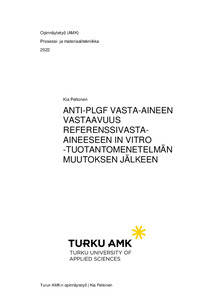Anti-PlGF vasta-aineen vastaavuus referenssivasta-aineeseen in vitro -tuotantomenetelmän muutoksen jälkeen
Peltonen, Kia (2022)
Peltonen, Kia
2022
All rights reserved. This publication is copyrighted. You may download, display and print it for Your own personal use. Commercial use is prohibited.
Julkaisun pysyvä osoite on
https://urn.fi/URN:NBN:fi:amk-2022060816646
https://urn.fi/URN:NBN:fi:amk-2022060816646
Tiivistelmä
Wallac Oy:n vasta-ainevalmistuksessa on meneillään projekti, jonka aikana siirretään vasta-aineiden tuotto uuteen solupussi-bioreaktoriin vanhasta ontelokuitubioreaktorista. Bioreaktori vaihdetaan, sillä vanhaan bioreaktoriin ei enää saa varaosia. Uudella bioreaktorilla voidaan myös tuottaa vasta-ainetta kolme kertaa nopeammin ja neljä kertaa edullisemmin kuin vanhalla bioreaktorilla.
Opinnäytetyön tavoitteena oli testata ja analysoida anti-PlGF vasta-aineen rakenteen ja toiminnallisuuden säilyminen samanlaisena in vitro tuotantomenetelmän muutoksen jälkeen. Uudella bioreaktorilla tuotettua vasta-ainetta verrattiin vanhalla bioreaktorilla tuotettuun referenssivasta-aineeseen laadunvalvonnallisilla testeillä. Laadunvalvonnassa käytettyjä testejä olivat spesifinen vasta-ainepitoisuuden määritys, SDS-PAGE, isoelektrinen fokusointi (IEF), kiihdytetty säilyvyysmääritys IEF:llä, affiniteettitestaus ja vasta-aineen Fab-osan massaspektrometrinen analysointi.
Spesifistä vasta-ainepitoisuuden määritystä käytettiin vasta-aineen puhdistuksen varmentamiseen. Käyttämällä SDS-PAGE:a, IEF:ää ja massaspektrometristä analyysia voitiin todeta, ettei vasta-aineen rakenteessa ollut tapahtunut merkitsevää muutosta bioreaktorin vaihdon jälkeen. Kiihdytetyllä säilyvyystestauksella todennettiin, ettei vasta-aineen säilyvyydessä ollut tapahtunut muutosta. Lisäksi affiniteettitestauksella voitiin varmistaa, ettei vasta-aineen antigeenispesifisyydessä ja antigeenin sitoutumiskinetiikassa vasta-aineeseen, ole tapahtunut merkitsevää muutosta.
Laadunvalvonnan tulosten perusteella voitiin todeta, että uudella bioreaktorilla tuotetun anti-PlGF vasta-aineen rakenne ja toiminnallisuus ovat pysyneet samanlaisina verrattuna vanhalla bioreaktorilla tuotettuun vasta-aineeseen. Jatkotestien jälkeen anti-PlGF vasta-aineen tuotto voidaan siirtää uuteen solupussi-bioreaktoriin. An ongoing project in Wallac Oy’s antibody manufacturing aims to transfer the antibody output from the old hollow fibre bioreactor to a new cell-bag bioreactor. The bioreactor will be replaced as there are no more spare parts available. The new bioreactor also produces antibodies three times faster and four times lower cost than the old bioreactor.
The aim of the thesis was to test and analyse whether the anti-PlGF antibody structure and functionality have remained the same even after the change in the in vitro production method. The antibody produced with the new bioreactor was compared to the reference antibody produced with the old bioreactor by quality-control tests. Tests used for quality control included specific antibody concentration determination, SDS-PAGE, isoelectric focusing (IEF), accelerated shelf-life assay with IEF, affinity testing, and mass spectrometric analysis of the Fab fragment of the antibody.
Specific antibody concentration determination was used to verify antibody purification. Using SDS-PAGE, IEF and mass spectrometric analysis, it was possible to establish that there has been no significant change in antibody structure after the bioreactor replacement. Accelerated shelf-life testing verified that there had been no change in the shelf-life of the antibody. In addition, affinity testing could ensure that there was no significant change in antigen specificity and antigen binding kinetics to the antibody.
Based on the quality control results, it could be determined that the structure and functionality of the anti-PLGF antibody produced with the new bioreactor have remained similar compared to the antibody produced with the old bioreactor. After further tests, the anti-PLGF antibody output can be transferred to the new cell-bag bioreactor.
Opinnäytetyön tavoitteena oli testata ja analysoida anti-PlGF vasta-aineen rakenteen ja toiminnallisuuden säilyminen samanlaisena in vitro tuotantomenetelmän muutoksen jälkeen. Uudella bioreaktorilla tuotettua vasta-ainetta verrattiin vanhalla bioreaktorilla tuotettuun referenssivasta-aineeseen laadunvalvonnallisilla testeillä. Laadunvalvonnassa käytettyjä testejä olivat spesifinen vasta-ainepitoisuuden määritys, SDS-PAGE, isoelektrinen fokusointi (IEF), kiihdytetty säilyvyysmääritys IEF:llä, affiniteettitestaus ja vasta-aineen Fab-osan massaspektrometrinen analysointi.
Spesifistä vasta-ainepitoisuuden määritystä käytettiin vasta-aineen puhdistuksen varmentamiseen. Käyttämällä SDS-PAGE:a, IEF:ää ja massaspektrometristä analyysia voitiin todeta, ettei vasta-aineen rakenteessa ollut tapahtunut merkitsevää muutosta bioreaktorin vaihdon jälkeen. Kiihdytetyllä säilyvyystestauksella todennettiin, ettei vasta-aineen säilyvyydessä ollut tapahtunut muutosta. Lisäksi affiniteettitestauksella voitiin varmistaa, ettei vasta-aineen antigeenispesifisyydessä ja antigeenin sitoutumiskinetiikassa vasta-aineeseen, ole tapahtunut merkitsevää muutosta.
Laadunvalvonnan tulosten perusteella voitiin todeta, että uudella bioreaktorilla tuotetun anti-PlGF vasta-aineen rakenne ja toiminnallisuus ovat pysyneet samanlaisina verrattuna vanhalla bioreaktorilla tuotettuun vasta-aineeseen. Jatkotestien jälkeen anti-PlGF vasta-aineen tuotto voidaan siirtää uuteen solupussi-bioreaktoriin.
The aim of the thesis was to test and analyse whether the anti-PlGF antibody structure and functionality have remained the same even after the change in the in vitro production method. The antibody produced with the new bioreactor was compared to the reference antibody produced with the old bioreactor by quality-control tests. Tests used for quality control included specific antibody concentration determination, SDS-PAGE, isoelectric focusing (IEF), accelerated shelf-life assay with IEF, affinity testing, and mass spectrometric analysis of the Fab fragment of the antibody.
Specific antibody concentration determination was used to verify antibody purification. Using SDS-PAGE, IEF and mass spectrometric analysis, it was possible to establish that there has been no significant change in antibody structure after the bioreactor replacement. Accelerated shelf-life testing verified that there had been no change in the shelf-life of the antibody. In addition, affinity testing could ensure that there was no significant change in antigen specificity and antigen binding kinetics to the antibody.
Based on the quality control results, it could be determined that the structure and functionality of the anti-PLGF antibody produced with the new bioreactor have remained similar compared to the antibody produced with the old bioreactor. After further tests, the anti-PLGF antibody output can be transferred to the new cell-bag bioreactor.
